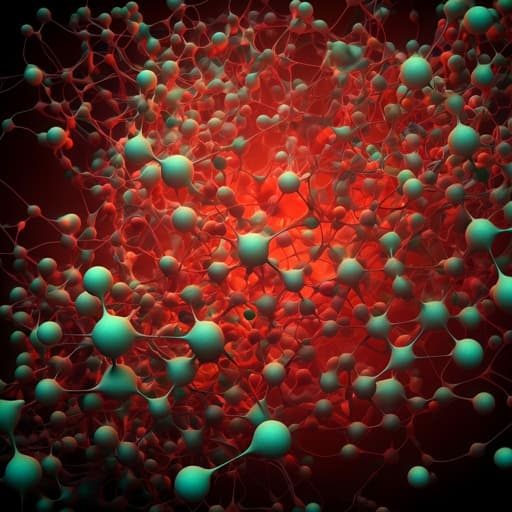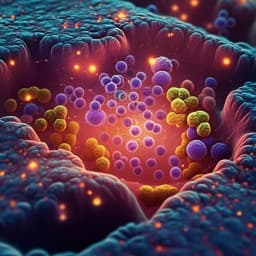
Medicine and Health
In Vitro Tumor Models on Chip and Integrated Microphysiological Analysis Platform (MAP) for Life Sciences and High-Throughput Drug Screening
H. Ngo, S. Amartumur, et al.
Discover how Huyen Ngo and colleagues are revolutionizing cancer research with advanced cancer-on-chip technology! This innovative approach tackles the complexities of the tumor microenvironment, providing high-throughput drug screening and personalized medicine solutions. Dive into the future of cancer biology and treatment!
~3 min • Beginner • English
Introduction
This review addresses the need for physiologically relevant human in vitro models to study cancer biology and improve drug development. Traditional 2D cultures lack tissue architecture and dynamic exchange, and animal models often fail to predict human responses due to genetic and physiological differences. Emerging 3D spheroids and organoids better mimic tissue organization but still lack vascular interfaces and dynamic perfusion. Organ-on-chips (OOCs), or microphysiological analysis platforms (MAPs), use compartmentalized microfluidics, tissue–tissue interfaces, and controlled flow to recapitulate organ function units and inter-organ crosstalk. The paper’s purpose is to summarize advances in cancer-on-chip technologies across cancer types, highlight how they model key hallmarks (invasion, intravasation, extravasation, metastasis, tumor niches), and discuss applications in high-throughput drug screening and precision medicine, including integration of biosensors for real-time monitoring.
Literature Review
The review synthesizes developments in cancer-on-chips that recapitulate tumor microenvironments (TMEs) and disease stages across multiple cancers:
- Key hallmarks and routes of metastasis (hematogenous, lymphatic, transcoelomic), emphasizing differences such as brain tumors’ local invasiveness with rare extracranial metastasis.
- Breast cancer-on-chip: devices modeling stromal invasion (ECM, fibroblasts, interstitial flow), extravasation in endothelialized and self-assembled vascular networks (including hypoxia-driven EMT/extravasation), organ-specific metastasis (bone vs muscle microenvironments; CXCL5–CXCR2 signaling; A3AR), intravasation in tumor–stroma–vessel tri-compartment chips, and roles of lymphatic vessels in drug drainage and resistance. Early metastasis chips reveal platelet-facilitated extravasation and the impact of antiplatelet therapy on endothelial junctions and invasive gene expression.
- Brain cancer (GBM)-on-chip: reconstruction of perivascular, invasive, and hypoxic niches; hyperangiogenesis driven by tumor–endothelium crosstalk (VEGF), oxygen/nutrient gradients generating necrotic cores, thrombosis-triggered pseudopalisading migration, and immune components (TAMs, T cells) shaping immunosuppressive environments and chemoresistance (HIF-1α, IL6).
- Gynecologic cancers: ovarian chips modeling interstitial flow-induced EMT and aggressiveness, platelet-mediated hematogenous metastasis via Gal3–GPVI; engineered hypoxic gradients to study metabolic adaptation. Cervical cancer chips examine hypoxia-regulated migration (HIF-1α, VEGF-165, ROS).
- Gastrointestinal cancers: gastric ECM droplet models inducing EMT and 5-FU resistance; colorectal tumor–stroma crosstalk driving CAF activation and taxane resistance; flow-induced phenotypic plasticity in esophageal cancer; tumor–endothelium VEGF-driven invasion; nanoparticle delivery kinetics.
- Lung cancer-on-chip: orthotopic alveolar/bronchiolar models with breathing motions regulating EGFR and TKI responses; multi-organ metastasis chips (lung–BBB–brain) to track brain tropism and identify mediators (AKR1B10); CAF-induced GRP78 promotes invasion.
- Liver and pancreatic cancer: stellate–tumor interactions, decellularized liver matrix under flow, transendothelial migration assays; pancreatic duct–vessel co-channels revealing TGF-β/activin/ALK7-mediated endothelial ablation and a leaf-venation-inspired multi-organ metastasis model indicating bone-preferential extravasation.
- Urinary tract cancers: bladder TME co-cultures with M2-like macrophages; ccRCC-on-chip demonstrating angiogenic mediators (ANGPTL4, PGF, VEGFA).
- Advantages of flow (nutrient/waste exchange, interstitial mechanical cues), shortened culture times that resolve disease stages and metastasis dynamics in hours–days, and high-throughput drug screening via concentration gradients, spheroid arrays, and multi-unit BBB chips.
- Integration of biosensors: TEER for barrier integrity, and real-time electrochemical/optical sensors for oxygen, pH, glucose, lactate, ROS, and neuronal activity (MEA). The review also covers material selection for oxygen control (e.g., COC, PMMA vs PDMS).
- Future directions: organoid–organ-on-chip synergy and vascularized human-on-a-chip for systemic PK/PD, efficacy, and toxicity assessments; scaling and multiplexing challenges.
Methodology
This is a narrative review that compiles and synthesizes findings from prior peer-reviewed studies on cancer-on-chip and MAP technologies from early cell culture analogs (1990s) through recent multi-organ, sensor-integrated platforms. The authors organize evidence by cancer type and biological process (invasion, intravasation, extravasation, metastasis, and tumor niches), highlighting representative microfluidic architectures, cell co-cultures, perfusion/flow regimes, biochemical and biophysical cues, and integrated sensing modalities. No new experimental data, systematic search protocol, or meta-analytic methods are reported; instead, the review draws on selected seminal and recent studies to illustrate capabilities, applications to drug screening, and translational potential.
Key Findings
- Cancer-on-chips recapitulate key anatomical and pathophysiological features of tumors, including stromal crosstalk, vascular interfaces, and dynamic flow, enabling real-time observation of invasion–metastasis cascades and tissue-specific tropism.
- Flow effects: Microfluidic interstitial flow (on the order of 10^-6 m/s) enhances viability, aggressiveness, EMT, and metastatic behaviors consistent with in vivo observations; devices improve nutrient/waste exchange vs static culture.
- Breast cancer:
- Extravasation increases with hypoxia via HIF signaling; tumor–endothelium models show cancer-induced vascular permeability and transmigration.
- Organotropism: Bone-mimicking microenvironments show higher MDA-MB-231 extravasation than collagen-only or skeletal muscle matrices; osteoblast-derived CXCL5 promotes extravasation via CXCR2; skeletal muscle anti-metastatic effects involve A3AR.
- Intravasation visualized in tri-compartment chips; cells degrade ECM, replace endothelial cells, and enter vessel lumens.
- Lymphatic vessels can drain drugs (e.g., doxorubicin), increasing tumor cell viability by reducing local drug concentration.
- Platelets enhance early metastatic niche formation and extravasation; antiplatelet treatment (e.g., eptifibatide) reduces invasive gene expression and strengthens endothelial junctions.
- GBM:
- Perivascular niche: tumor-endothelial crosstalk induces hyperangiogenesis (VEGF); GSC–endothelium contact maintains stemness, migration, and chemoresistance.
- Hypoxic niches: oxygen/nutrient gradients create necrotic cores and pseudopalisading; hypoxia elevates HIF-1α and IL6, conferring doxorubicin resistance; thrombosis-on-chip triggers directed migration toward perfused channels mimicking pseudopalisades.
- Invasive niche: blood vessels serve as migration highways; molecular signatures include PDGFRA-related programs and proneural/mesenchymal features.
- Immuno-chips reveal GBM subtype-specific immune and epigenetic signatures impacting immunosuppression and therapy.
- Lung cancer:
- Orthotopic alveolus/airway chips with mechanical breathing suppress EGFR expression and alter responses to TKIs (e.g., increased resistance to rociletinib) and impact tumor growth.
- Multi-organ lung–BBB–brain chips track metastasis: NSCLC cells traverse lung endothelium in ~2 days, reach BBB in ~1 day, with proliferation 24–36 h later; AKR1B10 promotes BBB exit and brain colonization.
- CAFs upregulate GRP78 in NSCLC cells, enhancing invasion.
- Gastrointestinal and gynecologic cancers:
- ECM and flow promote EMT and drug resistance (e.g., gastric cells to 5-FU; esophageal cells under laminar flow more mesenchymal and docetaxel-resistant).
- Ovarian models show interstitial flow restricts volume but increases aggressiveness; platelet–tumor interactions via Gal3–GPVI enhance metastasis; GPVI inhibition supports chemotherapy.
- Liver and pancreatic cancers:
- Stellate–tumor interactions drive activation and resistance; decellularized liver matrices under flow sustain function; pancreatic duct–vessel models show PDAC-induced endothelial apoptosis via TGF-β/activin/ALK7.
- Leaf-venation-inspired chips reveal higher pancreatic cancer extravasation into bone-like vs liver-like microenvironments.
- High-throughput drug screening:
- Concentration gradient generators and spheroid arrays enable multiplexed testing with physiological flow, small volumes, and patient-derived samples.
- 24-unit BBB–tumor arrays assess drug BBB penetration, tumor cytotoxicity, and endothelial toxicity simultaneously.
- Micro-ecology devices show rapid doxorubicin resistance emergence, with transcriptomic changes (e.g., FLNA mutation, AKR overexpression, NF-κB activation).
- Integrated sensing:
- TEER monitors barrier integrity (epithelium/endothelium) and drug-induced disruption.
- Electrochemical/optical sensors quantify O2, pH, glucose, lactate, and ROS in real time; MEA captures neuronal activity to assess tumor–neuron interactions.
- Materials and oxygen control:
- Thermoplastics (COC, PMMA, PS) reduce gas permeability and enable precise oxygen control; highly active hepatocytes deplete oxygen to ~4% within ~60 min on low-permeability devices, while PDMS elevates measured O2 due to atmospheric permeation.
Discussion
The compiled evidence shows that microfluidic cancer-on-chip and MAP platforms overcome key limitations of static cultures and improve translational relevance over animal models by replicating tissue architecture, mechanical cues, and perfusion. By enabling stromal, vascular, immune, and organ–organ interactions, these systems illuminate mechanisms of invasion, intravasation/extravasation, organotropism, hypoxia-driven resistance, and platelet/immune modulation of metastasis. Integrated biosensors and high-throughput designs allow quantitative, real-time assessment of barrier function, metabolism, electrophysiology, drug penetration (e.g., BBB), efficacy, toxicity, and resistance dynamics. Multi-organ linkages capture PK/PD and off-target toxicities, supporting precision oncology through patient-derived models and combinatorial screening. These findings support MAPs as valuable preclinical tools to identify targetable pathways (e.g., CXCL5–CXCR2, AKR1B10, ALK7) and optimize regimens that consider tumor ecology, microenvironmental flows, and barriers to delivery.
Conclusion
Cancer-on-chip and MAP technologies have matured into versatile platforms that recreate organ-level tumor microenvironments, metastatic cascades, and tumor niches, providing mechanistic insights and enabling more predictive drug screening than conventional models. The integration of biosensors for TEER, metabolites, ROS, and neuronal activity enhances spatiotemporal resolution of tumor dynamics and treatment responses. Combining organoids with organ-on-chip can merge patient-specific cellular heterogeneity with controlled biophysical cues, and vascularized multi-organ (human-on-a-chip) systems can capture systemic pharmacology and toxicities. Future work should focus on improving physiological fidelity (immune components, disease-specific ECM), material and manufacturing advances to reduce drug absorption and increase scalability, robust patient-derived cell sourcing, and standardized, high-throughput workflows to accelerate translation to precision medicine.
Limitations
- Biological: Current chips often include limited TME components and may omit key immune elements, blood cells, or organ-specific ECM, reducing fidelity. Commercial matrices (e.g., collagen I, laminin) do not capture tumor ECM heterogeneity; disease-, organ-, and patient-specific ECM materials are needed.
- Technical: PDMS absorbs hydrophobic small molecules, distorting drug dosing; alternative thermoplastics (PS, PMMA, COC) or surface treatments are needed. Device fabrication and operation can be complex, hindering scalability and reproducibility. Maintaining multiple cell types with distinct media requirements on a single platform is challenging.
- Cell sources: Reliance on immortalized cell lines limits patient relevance; tumor heterogeneity is underrepresented. Patient-derived cells/organoids and iPSC-derived models can improve precision but require standardization.
- Multiplexing and scaling: Accurate physiological scaling, vascularization, and potential innervation across connected organ modules remain difficult and can affect PK/PD predictions.
Related Publications
Explore these studies to deepen your understanding of the subject.







